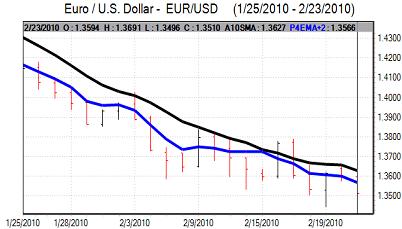EUR/USD
The Euro pushed higher as European markets opened on Tuesday and reached a high near 1.37 ahead of the German IFO release.
The index of business confidence was weaker than expected with a decline to 95.2 for February from 95.8 the previous month and contrary to expectations of a slight increase. The data is likely to have been distorted by bad weather, but the deterioration reinforced a lack of confidence in the Euro-zone economy and pushed the Euro significantly weaker.
There were also continuing fears surrounding the Greek situation as credit ratings for the commercial banks were downgraded and underlying Euro sentiment remained negative as government-debt fears remained a key influence.
The US economic data was also weaker than expected with consumer confidence dipping sharply to 46 for February from a revised 56.5 the previous month and this was the lowest figure for 10 months as confidence in the labour market deteriorated. This can be a trend at this stage of an economic cycle, but there will be fears over underlying weaknesses.
Interest rate expectations will tend to be scaled back further, especially with Regional Fed President Bullard stating that policy may not be tightened during 2010. Markets will watch comments from Fed Chairman Bernanke very closely later on Wednesday, although he is unlikely to take a hawkish stance.
Risk appetite deteriorated sharply following the consumer confidence data and this helped support the dollar despite the weak data with the Euro testing support levels just below 1.35 before a limited recovery.

Source: VantagePoint Intermarket Analysis Software
Call now and you will be provided with FREE recent forecasts
that are up to 86% accurate * 800-732-5407
If you would rather have the recent forecasts sent to you, please go here
Yen
The dollar was unable to regain any momentum against the yen during Tuesday and retreated to test 2-week lows just below the 90 level. There was some initial disappointment that the expected capital flows from Japan did not provide greater support to the dollar.
The yen also benefitted from the deterioration in risk appetite following the US data, especially once commodity currencies were subjected to strong selling pressure.
Japan recorded a trade surplus for January which could provide some yen support, although this month’s data is often distorted and the impact is likely to be limited with the dollar looking to hold above 90 in early Asia on Wednesday.
Sterling
Sterling pushed higher in European trade on Tuesday with a peak around 1.5575 against the dollar before the advance stalled. The currency was then subjected to heavy selling pressure following testimony from Bank of England officials on the inflation report.
Governor King stated that the economic recovery remained very fragile and that further quantitative easing remained a possibility with the decision reviewed on a monthly basis. The generally downbeat comments undermined Sterling support even though King also stated that the impact of quantitative easing had not yet been felt.
Underlying confidence in the currency also remains very weak as debt fears persist and there was also a weaker than expected reading for mortgage approvals which fell sharply for January.
There was a low close to 1.54 against the dollar before Sterling found support while the UK currency was resilient against the Euro with the Euro hitting tough resistance close to 0.8850.
Swiss franc
Following a jump higher in Asian trading on Tuesday, the Euro was able to maintain gains against the Swiss franc, but was unable to extend the advance and drifted back to the 1.4640 area on Wednesday as underlying Euro sentiment remained weak.
The dollar pushed to a high near 1.0850 against the franc before edging weaker. The franc should continue to gain some defensive support if there is a sustained deterioration in global risk appetite.
Higher volatility is likely to remain a key feature in the short term as markets will remain extremely nervous over the prospect of further National Bank intervention to stem franc appreciation.

Source: VantagePoint Intermarket Analysis Software
Call now and you will be provided with FREE recent forecasts
that are up to 86% accurate * 800-732-5407
If you would rather have the recent forecasts sent to you, please go here
Australian dollar
The Australian dollar pushed to a high of 0.9070 against the US dollar during Tuesday on optimism over the domestic economy and the possibility of further interest rate increases.
There was a sharp reversal in US trading as risk appetite deteriorated following the US data and there was a decline to lows near 0.89 against the US currency. The Australian dollar will find it difficult to regain strong support if fears over the global economy intensify.



